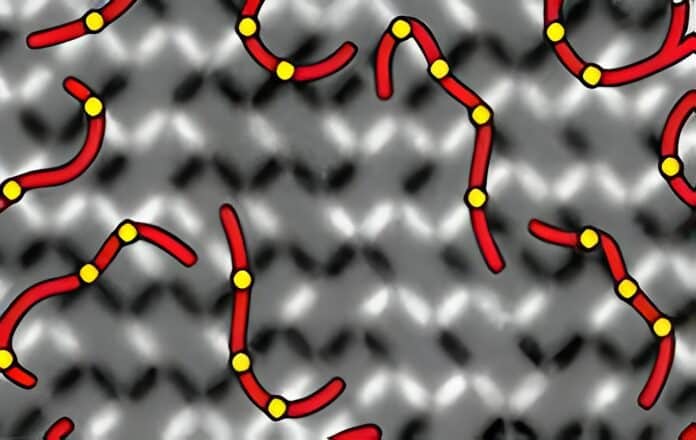Frustrated magnetic systems, such as spin ices, have a ground state where each spin has the lowest energy. This dissatisfaction may be seen through the magnetic moment configurations at the vertices of the magnetic array in an artificial spin ice geometry known as Santa Fe ice. The topology of a system can constrain ergodic kinetics, which is crucial to equilibrium thermodynamics.
A multi-institutional team studying the physics of collective behavior created and measured a nanomagnetic model array with the behavior best described as a series of wiggling strings. The strings, made up of connected spots of high energy within the lattice, can stretch and contract, but they can also reconnect. Strings can only connect to specified endpoints and must connect to them in specific ways.
These restrictions on the behavior of the strings illustrate what physicists refer to as topological behavior, which is connected to a variety of subjects, from the donut’s shape to how electrons move through some cutting-edge semiconductors.
Los Alamos National Laboratory researcher Cristiano Nisoli said, “Topological physics has raised much recent interest, mostly in the quantum domain. We had already demonstrated a few times, theoretically and experimentally, that features once believed to be inherently quantum can be reproduced by systems of classical interacting nanomagnets.”
According to co-author Yale applied physics professor Peter Schiffer, said, “This system is an instance in which topologically driven features appear in a purely classical material system—that makes them easier to study and characterize.”
The work is part of a continuing partnership between Schiffer and his team’s experimental work at Yale University and Nisoli’s group in the Los Alamos Theoretical division. Beginning in 2006, the two introduced the concept of “artificial spin ice” formations composed of interacting magnetic nano-islands from the bottom up.
He said, “Initially, we concentrated on simple geometries and models, sometimes mimicking existing natural materials, But since the beginning, the idea was more ambitious: instead of finding serendipitously exotic or useful phenomena in natural materials, we sought to produce artificial ones where new phenomena could be designed-in and checked in highly controllable ways, perhaps in view of future functionalities, such as memory storage or computation.”
The teams developed Santa Fe spin ice geometry, inspired by the shapes on a brick floor in Santa Fe, New Mexico. The researchers observed string merging and rejoining at high temperatures, resulting in the system switching between topologically unique structures.
The researcher said, “The interesting fact about Santa Fe spin ice is that, although it is made of a bunch of binary magnets, it can also be completely described as a set of continuous strings.”
The authors previously created the Santa Fe spin ice and showed the presence and behavior of these strings. They investigated how the strings travel in the current work. Using photoemission electron microscopy analysis performed at Berkeley, Schiffer from Yale University said, “It effectively provides video clips of the nanomagnets in space and time, so we could watch them as they spontaneously switched their north and south poles. The nano-islands are fabricated to be very thin, just a few nanometers, so that they flip their poles just from being at finite temperature, in a well-known phenomenon called superparamagnetism.”
He also said. “With the measurements we could perform, we were able to watch these nano-scale strings go through their motions and make an unexpected transition in behavior.”
However, string motion was limited to simple length and form changes below a particular temperature. This research demonstrates a dynamical crossover: below a particular temperature, topologically non-trivial moves are repressed, leaving only topologically trivial (wiggling, extending, contracting) moves.
Schiffer said, “This level of insight is unusual for any system, and it sets the stage for other topological studies in the future.”
Journal Reference:
- Zhang, X., Fitez, G., Subzwari, etal. Topological kinetic crossover in a nanomagnet array. Science. 10.1126/science.add6575
